|
| |
TIMESAVER
RULES
& OPERATION
|
| |
Original rules -
Extended rules
|
| |
| The fact that John Allen's
Timesaver has inspired so many others to build identical
or very similar layouts based on his switching puzzle has
led to a certain variation of the "set rules"
on how to play this switching game. |
| |
| Original rules |
| |
The original
rules put forward by John Allen consisted of two
components:
|
| |

|
|
RULE A1:
"Switch the five cars to their destinations
on the layout."
RULE
A2: "Complete the
switching as quickly as possible."
|
|
| |
| On the original Timesaver
layout, John Allen marked out the
destinations for each car before each
game session and then set up the cars in
their "starting positions",
which also stayed the same for every
round of the game. Time was a key element
in the game (as the name implies): you
had to make the right switching moves to
get the cars to where they were supposed
to end up, but you also had to do it as
quickly as possible. This also meant that
apart from thinking ahead to do as little
switching as possible you also had to be
nimble with the controls for the
locomotive (which on the original
Timesaver operated with a set speed, so
you could only change the direction of
travel of the locomotive).
A game of
Timesaver was therefore set up this way
to provide individual players with
absolutely the same game configuration,
so that at the end of a game session
(perhaps an evening at a club, or even an
entire day at public shows) you would
have a winner: the operater who got the
switching done in the shortest period of
time.
Any accidents such
as derailments etc. would earn the
switcher in charge a time penalty.
|
|
STARTING
POSITIONS
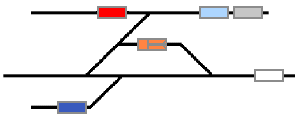
SWITCHING
ORDER (END POSITIONS)
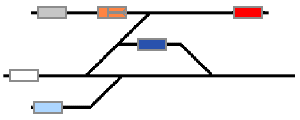
|
|
|
| |
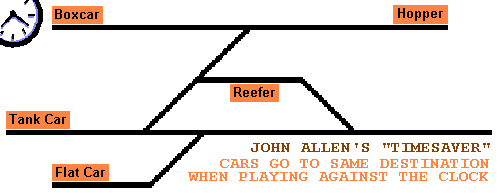 |
|
In this
illustration, five distinct types of freight cars
are used to make spotting the car easier and the
positions where the cars are required to end up
are marked down. Some
Timesaver layouts, especially those built for use
at public shows, have these destinations put down
permanently, i.e. they never change.
Below you can see all of these rules put
to work on the original Timesaver (together with
its duplicate twin layout in the foreground) at
the NMRA convention 2000 in San Josť. Orange
colour tabs indicate where cars are to be
switched to, and the late Allan Fenton (right)
oversees the switching in progress with a
stop-watch.
|
|
| |
Not
all people, however, appreciate the idea of
having to operate trains under the pressure of a
clock ticking away, so a variant rule emerged
very soon after John Allen first presented his
original Timesaver concept:
RULE A2
MODIFIED: "Complete
the switching with as few moves as
possible."
This obviously takes a bit of the
original challenge away, as it leaves the
operator with as much time to think about his
next moves as he likes - unless there is a set
amount of time for this (as in a tournament game
of chess) so that if you spend too much time
thinking to start with you will have none left
towards the end of the game.
Also, while it is fairly uncommon to
have two operators complete the switching in
exactly the same time, there are bound to be many
draws if the number of moves is used to determine
how well an operator has done if a large number
of players try their hand at the game.
|
|
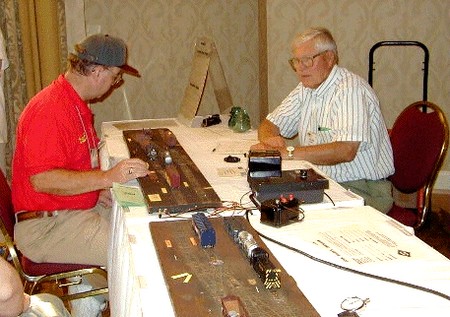
Picture by
Franz Reichl, used with kind permission
|
|
| |
| Extended rules |
| |
| John
Allen's original Timesaver layout was conceived entirely
as a brain teaser and with the movement of rolling stock
as its one and only objective. Quite logically, the
layout therefore wasn't more than just a
"gameboard", and the track was laid out much
the way tracks are reduced to a schematic on control
panels. There was thus no scenery or decoration of any
kind, and industries were simply indicated by markers
next to the tracks. No fuss, no frills - just operation. |
| |

The twin copy
of the original Timesaver (on display at the San
Diego Model Railroad Museum)
|
|
| |
| Again,
as with the element of the clock, a number of modellers
liked the basic Timesaver idea but felt that a bare
layout had little visual appeal and that this aspect
needed improvement. However, by adding scenery and
structures, the entire locale as well as the
individual industries take on a more specific character -
the layout turns into "an urban industrial zone
served by the Southern Pacific" rather than just
"the Timesaver" and the spot on the layout
which says "boxcar goes here" turns into the
"Western Tooling Co." In other words: the
layout comes to life in the sense that it now tries to
portray a more or less realistic scene in model form -
almost like setting the stage for a theatrical play. This
transition also tends to have an influence on how stock
is moved on many scenicked Timesaver layouts. |
| |
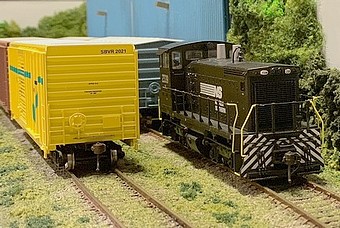 |
|
As the layout's visual make-up
becomes more realistic, introducing more
realistic switching orders than the basic
Timesaver balances the layout's
interesting scenery with interesting
operation. Most often, the preliminary
rule of such an "extended
operation" of a Timesaver layouts
is:
RULE
B1: "Switch
the five cars to
randomly assigned destinations on the
layout."
Taking into
account the fact that in real life it is
highly unlikely that exactly the same car
would get switched to exactly the same
location over and over again, the element
of randomly deciding where the five cars
are to go is introduced.
|
|
|
| |
| The switching gets
under way once the five cars on the layout have been
randomly assigned to the five possible destinations A-E. This
operation scheme is still very much based on the original
rules and still works on the "one destination, one
car" principle, meaning that every destination is
always assigned exactly one car. However, as there is
room for more than a total of 5 cars at destinations A-E,
additional items of rolling stock can be introduced:
|
RULE B1
MODIFIED: "Switch a
random number of cars to randomly assigned
destinations."
This extended operation scheme does not
stick to an equal distribution of cars and may
therefore assign more than one car to a
destination or none at all, making sure that the
maximum track capacity is not exceeded, i.e.
"D" cannot receive more than 2 cars.
Note that the numbers given in the
illustration below for track capacity include the
locomotive, i.e. there is no extra length for the
switcher.
|
|
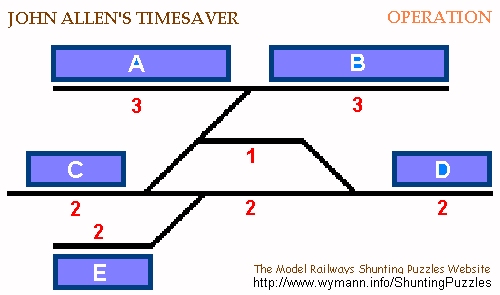
|
|
| |
| Therefore, if by
chance two boxcars need to be spotted at both industries
"C" and "D", careful planning is
required as to how and when they are set out - otherwise
the run-round loop will become completely blocked... There
are numerous ways of randomly assigning cars to
destinations. With only five destinations to handle, some
very basic systems (such as colour-coding the
destinations and then using a dice displaying these
colours, or just giving the destinations numbers from 1-5
and using an ordinary dice) will work fine.
|
| |
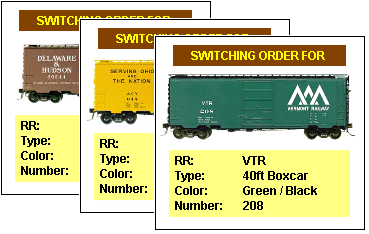 |
|
However, some slightly more
intricate systems can add even more
operational interest, especially if the
Timesaver layout is not seen as a
self-contained system (as in fact the
original is) but connected to the outside
world, which then could result in some
cars going "off scene" while
others take their place. In this case,
some form of card system is usually
introduced to put to work another
possible rule:
RULE
B2:
"Switching according to rule B1 / B1 modified is based on
an operational concept which
determines traffic flow."
Above all, this
rule makes sure that the traffic flow on
the layout is purposeful and
prevents cars being assigned to
destinations where they wouldn't be
needed on a real railroad.
|
| |
|
|
|
|
| Therefore,
customer A, who is a book printer and receives paper and
ships books by rail, will not be sent tank cars and coal
hoppers to his loading dock, because rule B2 makes sure that the specific types of freight
received and shipped by each industry on the layout are
determined so that only appropriate rolling stock may be
delivered to any given industry. Although
this rule makes for more realistic operation, it also
adds to the complexity of the whole system of randomly
assigning cars to locations (unless all destinations are
defined as receiving and sending goods using the same
type of rolling stock, i.e. all customers served only
require boxcars). Not surprisingly, therefore, Timesaver
layouts operating on the "extended rules" have
often done away completely with the aspect of switching
against the clock.
|
| |
| You can get a
first-hand impression of what it's like to operate a
"Timesaver" layout straight away, thanks to
Neil Machin's virtual "Timesaver"
switching puzzle,
which - amazingly - has been around since 2003. |
| |
 
|
| |
Back to the Model
Railways Shunting Puzzles Website main page

|
| |
Page
created: 18/OCT/2002
Last revised: 09/JAN/2024
|











